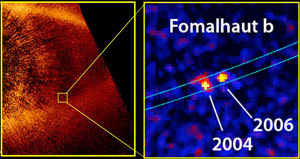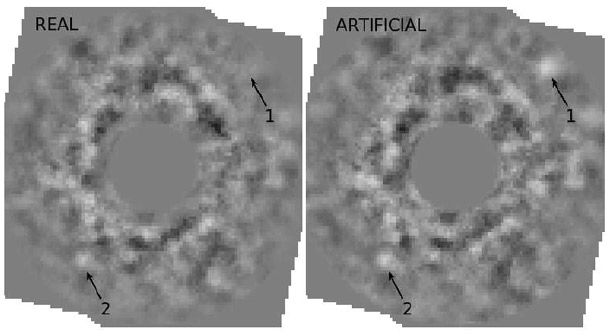Create a free profile to get unlimited access to exclusive videos, sweepstakes, and more!
Does the planet Fomalhaut b exist?
Well, this is depressing: Fomalhaut b may not exist.
 Fomalhaut is one of the brightest stars in the sky, and is only about 25 light years away -- that's close, on a cosmic scale. It's young, not more than a few hundred million years old, and surrounded by a vast ring of dust, leftover from the formation of the star itself. The ring is about 20 billion km (12 billion miles) in radius, and has a sharp inner edge.
Fomalhaut is one of the brightest stars in the sky, and is only about 25 light years away -- that's close, on a cosmic scale. It's young, not more than a few hundred million years old, and surrounded by a vast ring of dust, leftover from the formation of the star itself. The ring is about 20 billion km (12 billion miles) in radius, and has a sharp inner edge.
That last bit is important: the easiest way we know to make the inside edge that well-defined is if a planet is orbiting the star just inside the ring. Its gravity would draw in particles, sculpting what would otherwise be a fuzzy boundary into a clean-cut ring. Not only that, but the ring is off-center; again, that's likely due to the gravitational influence of a planet.
In 2008, astronomers announced they had found that planet: it appeared in two different Hubble Space Telescope images (shown above; click to embiggen) separated by two years. During that time, it had moved a little bit, by just what you'd expect for a planet at that distance from the star. The news came out the same day as other planets were seen around a different star, and I, along with lots of other folks, made it a headline (see the gallery at the bottom of this post showing all the planets we've been able to detect directly in images). This was, after all the first direct detection of a planet orbiting a Sun-like star!
Except, maybe not so much. A new paper has come out (PDF) trying to see Fomalhaut b using the Spitzer Space Telescope. Spitzer is sensitive to infrared, where the planet is far brighter.
And what did they see? Nothing.
Dang.

This image is pretty damning for the existence of Fomalhaut b. It's the Spitzer infrared observations of the star, with the star's light carefully removed. On the left is the actual image, and on the right they artificially added a point of light calculated to be equal to what the planet would emit, in the same position the planet should be -- that's what Arrow 1 is pointing at. It should be one of the brightest things in the image (Arrow 2 points to an unrelated bright spot). And while it's obvious on the right, nothing can be seen on the left, in the real image. In other words, the planet isn't seen.
Dang again.
Looking over the paper, it's clear the astronomers were very careful, and did a number of tests. There's no known way to make a planet as bright as what was seen in the Hubble images yet invisible in the Spitzer images. If the planet were there, they should've seen it. Also, a recent study has shown that if the two images show the planet moving, it would be on an orbit that crosses the ring! That seems extremely unlikely, if not outright impossible. A planet that big and massive -- more massive than Jupiter -- would disrupt the ring in short order if it physically crossed it. That really does make it very, very likely this is not a planet*.
So what is it? It's probably a clump of dust orbiting the star, reflecting light from the star enough to show up in the Hubble images but not warm enough to show up in the infrared observations.
That's too bad. If this is true -- and it probably is -- then that takes away one of the very few planets directly seen in telescopic observations. However, there are still plenty more, and those have been confirmed (again, see the gallery below). And that number will tend to increase as time goes on, even if every now and again it drops by one or two.
Hmph. I once wrote that destroying a planet is hard. Sometimes, all you need to do is try to observe it a different way, and poof! It's gone.
And now I have to update that gallery, and all my previous pages about it too. Dang science. Always learning more stuff and changing what we thought we knew.
Image credit: Paul Kalas, U C Berkeley; NASA/Spitzer/Markus Janson et al.
* I chatted with an astronomer friend of mine about this, and he agreed with the authors of this new study. "Overall," he wrote me, "it smells like fish.". I couldn't help myself. I wrote him back: "Of course it does. Fomalhaut is the brightest star in Pisces!"
[Below is a gallery of exoplanets that have been directly imaged using telescopes on ground and in space. Click the thumbnail picture to get a bigger picture and more information, and scroll through the gallery using the left and right arrows.]














